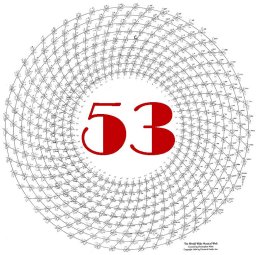Next Page: 12/3 – Mathieu’s Magic Mode
Dronal vs. Chordal Music;
Monophony vs. Polyphony
*Simple*
“We have nine moods, ranging from peacefulness to praying, or the feeling of emptiness you get by sitting by the ocean.” –Ravi Shankar on Indian Raga
“It was as though eternal harmony were conversing with itself, much as it must have happened in God’s bosom shortly before He created the universe. Thus profoundly was my soul stirred that I felt that I had neither eyes nor ears nor any other sense, and had no need of them.” –Goethe on the polyphony of Bach
As we had mentioned in earlier chapters, one limitation inherent in pure just intonation is the fact that every pitch has only one meaning in relation to the tonic. As a result, modulation (changing keys) is almost impossible unless you have hundreds of notes per octave in your palette. An ancient Chinese musician could create a flute with seven or maybe twelve holes per octave. Therefore, the ancient cultures would often pick a tonic pitch and never leave it. In the case of the Chinese, the tonic would remain fixed for centuries!
This tuning necessity then became a part of the religious and spiritual ethos of much of ancient music. China, the early Catholic and Byzantine Churches, and India especially treated the tonic as some version of the Om, that fixed center-of-the-universe, heart-of-all-being Divine place out of which all kinds of musical variation would rise from and return. Thus, dronal music, with its fixed tonic pitch, became an esthetic rule, even a spiritual commandment. The unchanging quality of the music of the ancients also often served as a reflection of a rigid, static, caste-bound society. In the ancient Catholic tradition, it fit nicely with the geocentric view of Earth as the unmoving center of the physical universe — and God the unmoving spiritual center.
In Indian music, the drone is constantly sounded as the tonic and the perfect fifth or some other interval, which are endlessly played on the tamboura. The tonic or the tonic and fifth can be heard around the world in ancient sacred choral music as well. Dronal music can seem boring at first, but the best dronal music can have an incredibly contemplative, grounded quality where amazing variation and harmonic complexity arises around this fixed center. Even if you don’t generally employ pure dronality in your compositions, there is a lot to be learned from exploring its esthetic possibilities. Bach, that polyphonic wizard of modulation and harmonic transformation in all 24 keys, began his Well-Tempered Clavier Book One with a piece that brilliantly combines dronality and harmonic movement. We call this the pedal tone in Baroque music. Listen to this excerpt and you’ll hear what I mean. From around 1:27 to 2:10, he plays only a long dominant dronal bass note and then the tonic, while building harmonic tension above it. In Western music, these whiffs of dronality usually appear in the bass line. But the drone can also be tossed about like a football from bass to alto to tenor to soprano, with interesting syncopations. As the drone plays on or bounces along, you can even add complex and even dissonant chord progressions on top. The drone’s sounding at the same time is a powerful reminder of where “home” is!
In India, musicians travel even further than Bach ever did from the dronal tonic-dominant pair, as we have seen. Indian scales routinely travel up and down the Pythagorean spine, but also two Just Thirds up (and sometimes two Just Thirds down). Singers listen with extreme care to the drone, then find their way to a rich array of complex harmonic relationships.
If you would like to learn more about this chapter, “Monophony vs. Polyphony,” you can buy the entire book, The Grand Unified Theory of Music, in pdf form for $25 with hundreds of embedded musical examples of scales and chords from all over the world.
A free introduction to what The Grand Unified Theory of Music offers is on this website and includes both text and a few musical examples from each webpage. If you would like to learn more about this chapter and the full contents of this entire e-book, you can buy The Grand Unified Theory of Music for $25, with hundreds of embedded musical examples of scales and chords from all over the world — and ideas for how to set up your computer system —
HERE.
You’ll get a personalized password you can use to see the entire e-book. Inside the full book, you will also get a link to the complete pdf file of this e-book, which you can read on your Kindle or similar device. The links to the hundreds of mp3 sound files – the same ones you can hear on the website — will also be included. This is “Version 1.0” of The Grand Unified Theory of Music. Because it is an e-book, additions, corrections and improvements in the sound may be added at any time. The Grand Unified Theory of Music is Copyright © 2018 by Christopher Mohr. All rights reserved.
One person per password. Sharing this password with others is a violation of copyright. Do not allow others to use your password or link to the pdf file!
